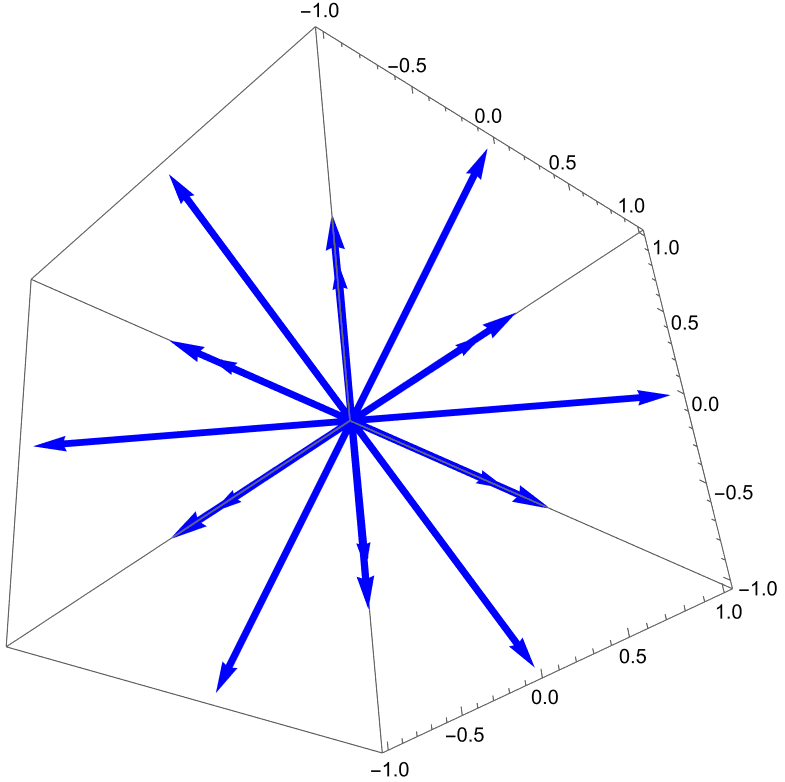The root lattice of $\mathfrak{so}(7)$ is given by the following 18 roots:
$$ \left(\begin{array}{c}0\\0\\1\end{array}\right) , \left(\begin{array}{c}0\\0\\-1\end{array}\right) , \left(\begin{array}{c}1\\1\\0\end{array}\right) , \left(\begin{array}{c}-1\\1\\0\end{array}\right) , \left(\begin{array}{c}1\\-1\\0\end{array}\right) , \left(\begin{array}{c}-1\\-1\\0\end{array}\right) , \left(\begin{array}{c}1\\0\\0\end{array}\right) , \left(\begin{array}{c}-1\\0\\0\end{array}\right) , \left(\begin{array}{c}0\\1\\0\end{array}\right) , \left(\begin{array}{c}0\\-1\\0\end{array}\right) , \left(\begin{array}{c}1\\0\\1\end{array}\right) , \left(\begin{array}{c}-1\\0\\1\end{array}\right) , \left(\begin{array}{c}0\\1\\1\end{array}\right) , \left(\begin{array}{c}0\\-1\\1\end{array}\right) , \left(\begin{array}{c}1\\0\\-1\end{array}\right) , \left(\begin{array}{c}-1\\0\\-1\end{array}\right) , \left(\begin{array}{c}0\\1\\-1\end{array}\right) , \left(\begin{array}{c}0\\-1\\-1\end{array}\right) $$
Its root lattices looks like this:
$\mathfrak{g}_2$ is a sub algebra of $\mathfrak{so}(7)$. So it seems naturally to ask, whether there is a relation between the two root lattices. The root lattice of $\mathfrak{g}_2$ is two-dimensional.
The roots are given by:
$$ \left(\begin{array}{c}0\\\sqrt{3}\end{array}\right) , \left(\begin{array}{c}0\\-\sqrt{3}\end{array}\right) , \left(\begin{array}{c}\frac{1}{2}\\\frac{\sqrt{3}}{2}\end{array}\right) , \left(\begin{array}{c}\frac{1}{2}\\-\frac{\sqrt{3}}{2}\end{array}\right) , \left(\begin{array}{c}-\frac{1}{2}\\\frac{\sqrt{3}}{2}\end{array}\right) , \left(\begin{array}{c}-\frac{1}{2}\\-\frac{\sqrt{3}}{2}\end{array}\right) , \left(\begin{array}{c}1\\0\end{array}\right) , \left(\begin{array}{c}-1\\0\end{array}\right) , \left(\begin{array}{c}\frac{3}{2}\\\frac{\sqrt{3}}{2}\end{array}\right) , \left(\begin{array}{c}\frac{3}{2}\\-\frac{\sqrt{3}}{2}\end{array}\right) , \left(\begin{array}{c}-\frac{3}{2}\\\frac{\sqrt{3}}{2}\end{array}\right) , \left(\begin{array}{c}-\frac{3}{2}\\-\frac{\sqrt{3}}{2}\end{array}\right) $$
and they look like:
 Is it possible to obtain some scaled version of this root lattice from a projection of the root lattice of $\mathfrak{so}(7)$ onto a particular plane?
Is it possible to obtain some scaled version of this root lattice from a projection of the root lattice of $\mathfrak{so}(7)$ onto a particular plane?
An experimental attempt lets me rotate the root lattice of $\mathfrak{so}(7)$ that the root structure is similar to the one of $\mathfrak{g}_2$ but the lengths of merging roots do not match:


